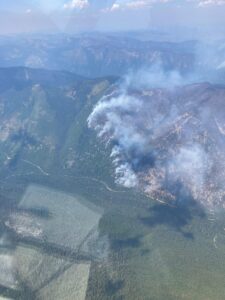
Good Afternoon! The August/September/October Wildland Fire Potential Outlook was posted this morning, and it doesn’t contain good news for the North Fork or Montana.
In contrast to the July Outlook, the August Outlook projects Above Normal Wildland Fire Potential to extend through September in addition to August. The July Outlook had us returning to normal in September. Above Normal conditions will persist in October on the Eastside. Northwest Montana should return to normal in October. Here are some excerpts:
Northern Rockies: Significant wildland fire potential in the Northern Rockies in August and September is expected to be above normal for most areas but return to normal in eastern North Dakota. In October, significant fire potential is expected to remain above normal for PSAs 10, 11, and 13-16 (Eastside). All the Northern Rockies are expected to return to normal fire potential in November.
Hot and generally dry conditions continued for the bulk of the Northern Rockies during the past month due to persistent much stronger than average upper-level ridging that extended north from the Great Basin. Only small pockets of significant precipitation occurred in eastern Montana and North Dakota. Every major climate reporting station in the Northern Rockies just experienced their warmest or second warmest-ever 30 days in the 1948-2021 period of record. All precipitation during the past month has been convective in nature resulting from periodic monsoon moisture surges rotating around the strong Southwest and Great Basin upper-level ridging. Thus, the rainfall was very short in duration and its fuel moistening effects were limited. As a result, the only areas in the Northern Rockies not in severe or greater drought are in portions of western and north-central Montana. More than half of northern Idaho remains in extreme or exceptional drought, as does much of central and eastern Montana.
100-hour and 1000-hour dead fuel moistures are at or near historic lows in most areas, especially in northern Idaho Panhandle and northwest Montana. Fine fuels have been cured for several weeks in the lower elevations west of the Divide, in the plains of central and eastern Montana, and western North Dakota. Live fuel moistures are generally below-average most areas and continue to drop, with drought stress effects appearing in many shrubs and conifers in the western PSAs. Therefore, the live fuels are no longer considered barriers to fire spread in these areas. (Note: Live fuels in the North Fork under a shaded canopy still have reasonable fuel moisture – but they are curing out quickly).
The full report is attached as a PDF or available online. We still have two full months of fire season left, folks. Stay vigilant!!
https://www.nifc.gov/nicc/predictive/outlooks/monthly_seasonal_outlook.pdf
Allen